1987 TOYOTA CELICA oil
[x] Cancel search: oilPage 4 of 346
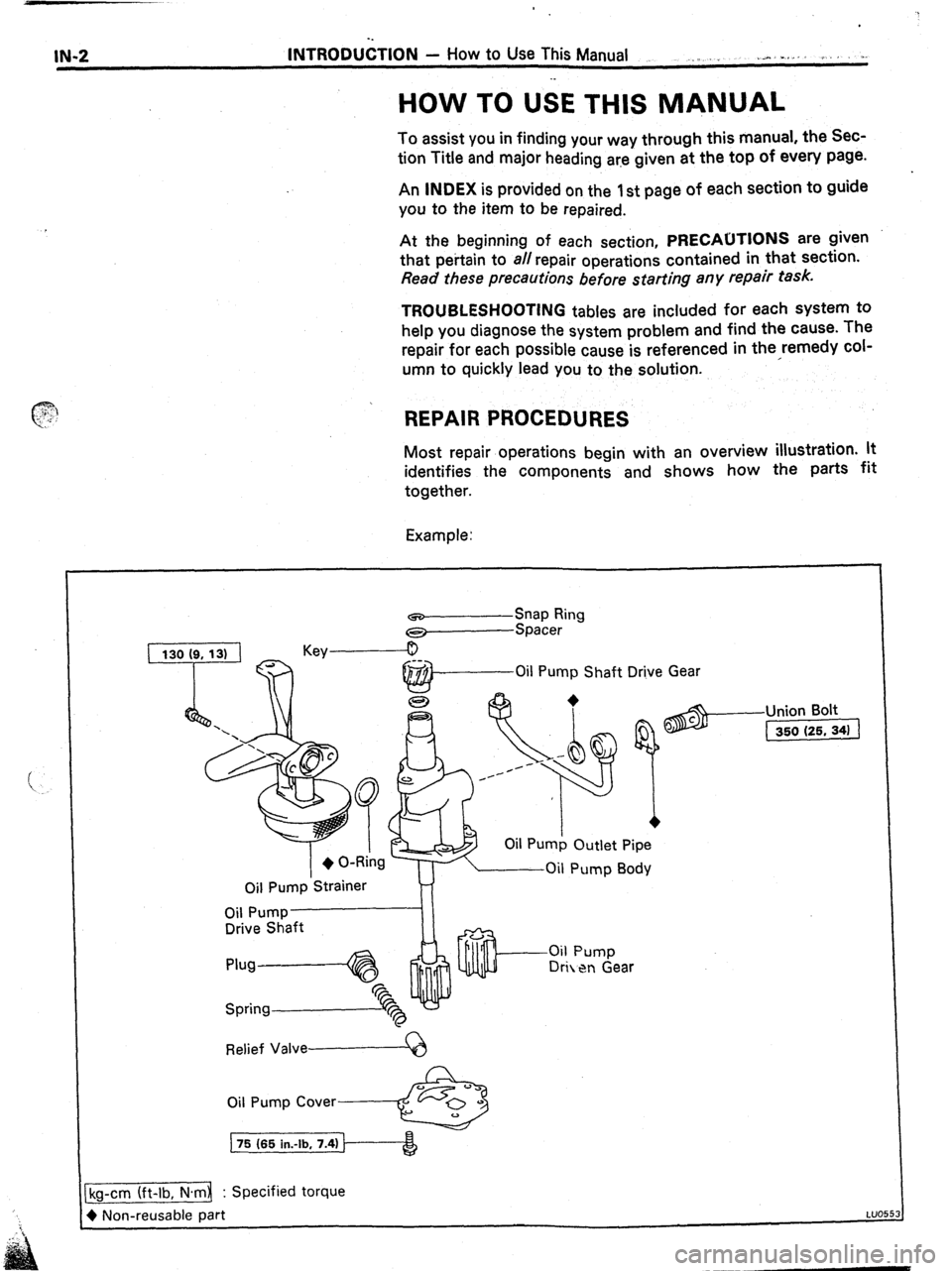
IN-2 INTRODUiTlON - How to Use This Manual
._. ._. -,-. . .
.
HOW TO USE THIS MANUAL
To assist you in finding your way through this manual, the Set-
tion Title and major heading are given at the top of every page.
An INDEX is provided on the 1 st page of each section to guide
YOU to the item to be repaired.
At the beginning of each section, PRECAUTIONS are given
that pertain to al/repair operations contained in that section. Read these precautions before starting any repair task.
TROUBLESHOOTING tables are included for each system to
help you diagnose the system problem and find the cause. The
repair for each possible cause is referenced in the remedy
COI-
umn to quickly lead you to the solution.
REPAIR PROCEDURES
Most repair operations begin with an overview illustration. lt
identifies the components and shows how the
patiS fit
together.
Example:
Oil Pump
Shaft Drive Gear
Oil Pump Outlet Pipe
Oil Pump
Strainer
Drive Shaft
Relief Valve------Q
Oil Pump Cover------&
75 (65 in.-lb, 7.4)
-Union Bolt
(1
cg-cm (ft-lb, N.m : Specified torque
) Non-reusable part
LUO5
Page 6 of 346
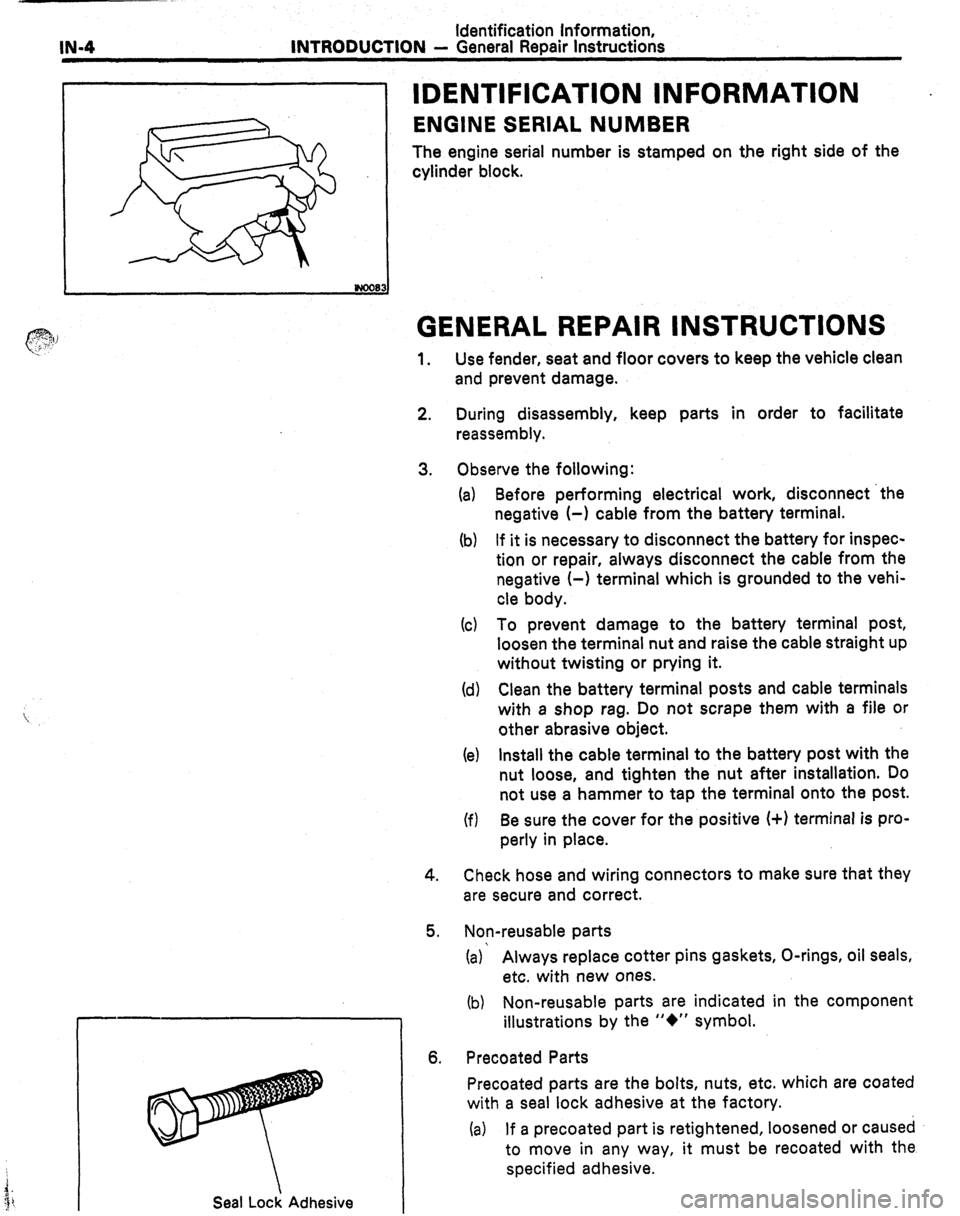
IN-4 Identification Information,
INTRODUCTION - General Repair Instructions
IDENTIFICATION INFORMATION
ENGINE SERIAL NUMBER
The engine serial number is stamped on the right side of the
cylinder block.
Seal Lock Adhesive
GENERAL REPAIR INSTRUCTIONS
1. Use fender, seat and floor covers to keep the vehicle clean
and prevent damage.
2.
3. During disassembly, keep parts in order to facilitate
reassembly.
Observe the following:
(a)
(b) Before performing electrical work, disconnect ‘the
negative (-1 cable from the battery terminal.
If it is necessary to disconnect the battery for inspec-
tion or repair, always disconnect the cable from the
negative (-) terminal which is grounded to the vehi-
cle body.
(c) To prevent damage to the battery terminal post,
loosen the terminal nut and raise the cable straight up
without twisting or prying it.
(d) Clean the battery terminal posts and cable terminals
with a shop rag. Do not scrape them with a file or
other abrasive object.
(e)
(f) Install the cable terminal to the battery post with the
nut loose, and tighten the nut after installation. Do
not use a hammer to tap the terminal onto the post.
Be sure the cover for the positive (+I terminal is pro-
perly in place.
4.
5. Check hose and wiring connectors to make sure that they
are secure and correct.
Non-reusable parts
(a)’ Always replace cotter pins gaskets, O-rings, oil seals,
etc. with new ones.
(b) Non-reusable parts are indicated in the component
illustrations by the “+” symbol.
6. Precoated Parts
Precoated parts are the bolts, nuts, etc. which are coated
with a seal lock adhesive at the factory.
(a) If a precoated part is retightened, loosened or caused
to move in any way, it must be recoated with the
specified adhesive.
Page 23 of 346
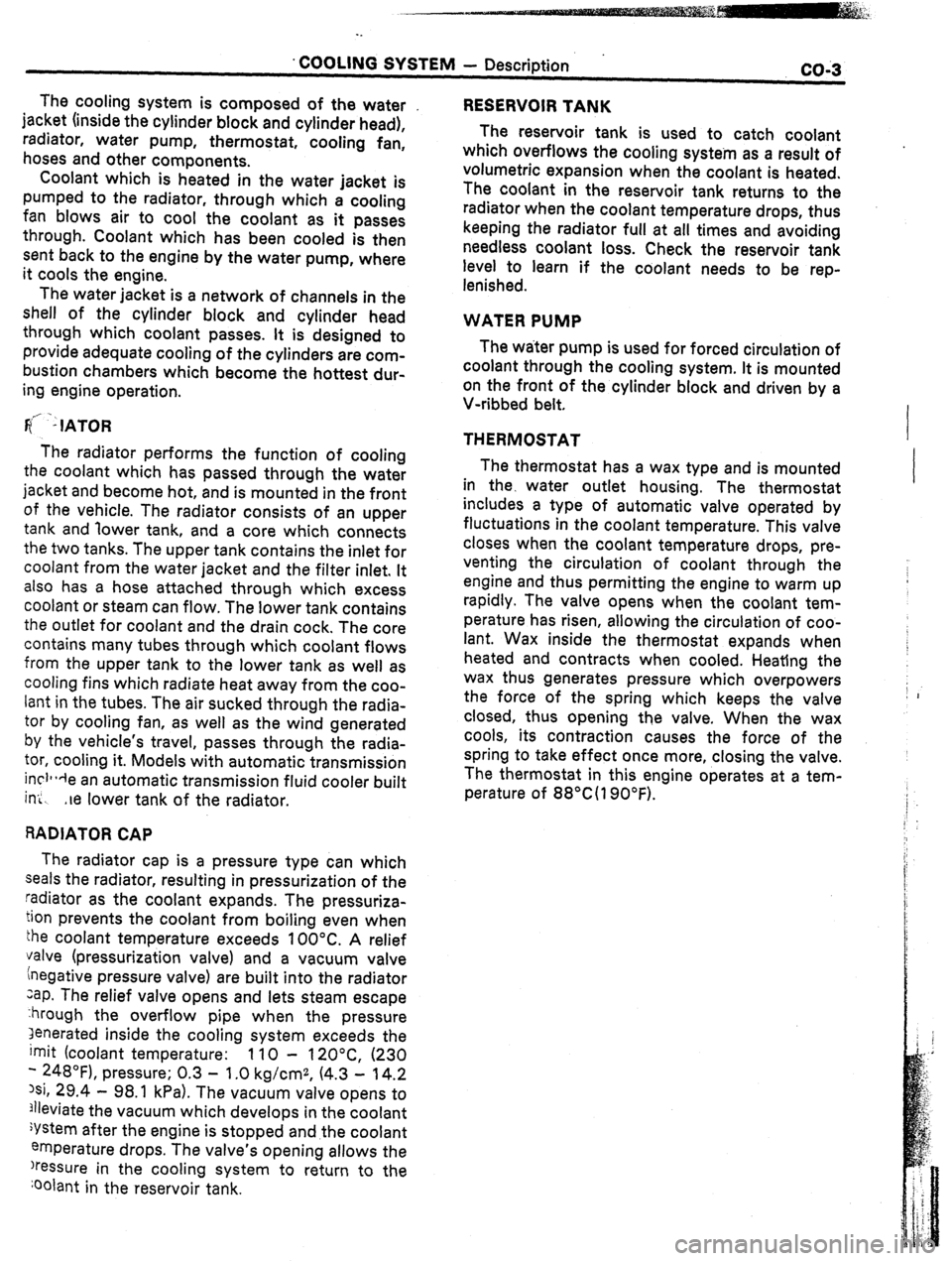
. COOLING SYSTEM - Description
co;3
RESERVOIR TANK
The reservoir tank is used to catch coolant
which overflows the cooling systein as a result of
volumetric expansion when the coolant is heated.
The coolant in the reservoir tank returns to the
radiator when the coolant temperature drops, thus
keeping the radiator full at all times and avoiding
needless coolant loss. Check the reservoir tank
level to learn if the coolant needs to be rep-
lenished.
WATER PUMP
The water pump is used for forced circulation of
coolant through the cooling system. It is mounted
on the front of the cylinder block and driven by a
V-ribbed belt,
THERMOSTAT I The cooling system is composed of the water
jacket (inside the cylinder block and cylinder head),
radiator, water pump, thermostat, cooling fan,
hoses and other components.
Coolant which is heated in the water
jacket is
pumped to the radiator, through which a cooling
fan blows air to cool the coolant as it passes
through. Coolant which has been cooled is then
sent back to the engine by the water pump, where
it cools the engine.
The water jacket is a network of channels in the
shell of the cylinder block and cylinder head
through which coolant passes. It is designed to
provide adequate cooling of the cylinders are com-
bustion chambers which become the hottest dur-
ing engine operation.
F(/ “ IATOR
The radiator performs the function of cooling
the coolant which has passed through the water
jacket and become hot, and is mounted in the front
of the vehicle. The radiator consists of an upper
tank and ‘lower tank, and a core which connects
the two tanks. The upper tank contains the inlet for
coolant from the water jacket and the filter inlet. It
also has a hose attached through which excess
coolant or steam can flow. The lower tank contains
the outlet for coolant and the drain cock. The core
contains many tubes through which coolant flows
from the upper tank to the lower tank as well as
cooling fins which radiate heat away from the coo-
lant in the tubes. The air sucked through the radia-
tor by cooling fan, as well as the wind generated
by the vehicle’s travel, passes through the radia-
tor, cooling it. Models with automatic transmission
incrl*-le an automatic transmission fluid cooler built
in:.
.le lower tank of the radiator.
RADIATOR CAP
The radiator cap is a pressure type can which
seals the radiator, resulting in pressurization of the
radiator as the coolant expands. The pressuriza-
tion prevents the coolant from boiling even when
the coolant temperature exceeds 100°C. A relief
valve (pressurization valve) and a vacuum valve
(negative pressure valve) are built into the radiator
zap. The relief valve opens and lets steam escape
:hrough the overflow pipe when the pressure
3enerated inside the cooling system exceeds the
imit (coolant temperature:
110 - 1 20°C, (230
- 248”F), pressure; 0.3 - 1 .O kg/cmz, (4.3 - 14.2
)si, 29.4 - 98.1 kPa). The vacuum valve opens to
3ljeviate the vacuum which develops in the coolant
system after the engine is stopped and the coolant
emperature drops. The valve’s opening allows the
)ressure in the cooling system to return to the
Qclant in the reservoir tank. The thermostat has a wax type and is mounted
in the. water outlet housing. The thermostat
includes a type of automatic valve operated by
fluctuations in the coolant temperature. This valve
closes when the coolant temperature drops, pre-
venting the circulation of coolant through the
engine and thus permitting the engine to warm up
rapidly. The valve opens when the coolant tem-
perature has risen, allowing the circulation of coo-
lant. Wax inside the thermostat expands when
heated and contracts when cooled. Heating the
wax thus generates pressure which overpowers
the force of the spring which keeps the valve
closed, thus opening the valve. When the wax
cools, its contraction causes the force of the
spring to take effect once more, closing the valve.
The thermostat in this engine operates at a tem-
perature of 88”C(19O”F).
I
I
Page 25 of 346
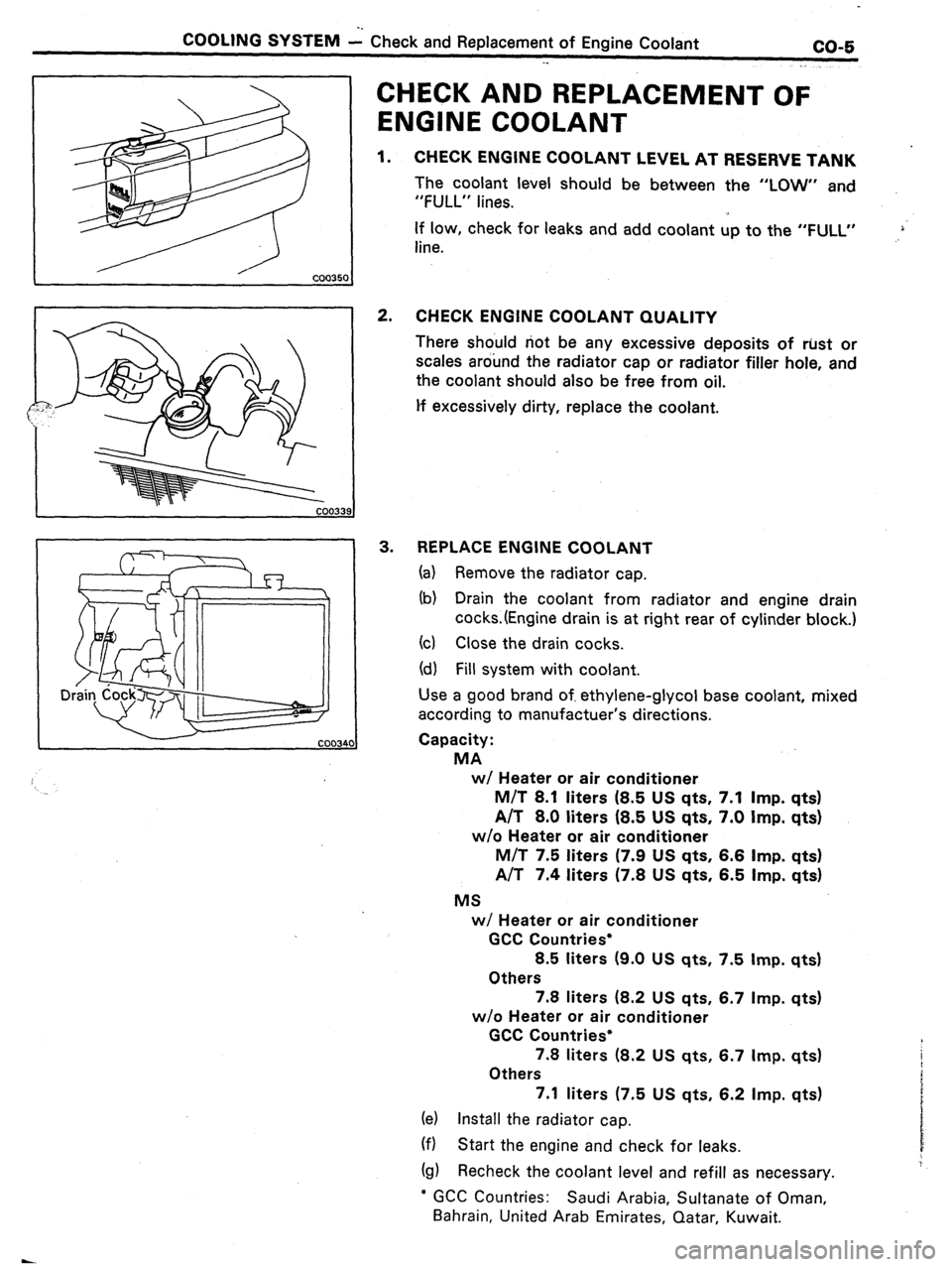
COOLING SYSTEM i Check and Replacement of Engine Coolant
co-5
._
CHECK AND REPLACEMENT OF
ENGINE COOLANT
1. CHECK ENGINE COOLANT LEVEL AT RESERVE TANK
The coolant level should be between the “LOW” and
“FULL” lines.
If low, check for leaks and add coolant up to the “FULL”
line. .,>‘
2. CHECK ENGINE COOLANT QUALITY
There should not be any excessive deposits of rust or
scales around the radiator cap or radiator filler hole, and
the coolant should also be free from oil.
lf excessively dirty, replace the coolant.
3. REPLACE ENGINE COOLANT
(a) Remove the radiator cap.
(b) Drain the coolant from radiator and engine drain
cocks.(Engine drain is at right rear of cylinder block.)
(cl Close the drain cocks.
(d) Fill system with coolant.
Use a good brand of. ethylene-glycol base coolant, mixed
according to manufactuer’s directions.
Capacity:
MA
w/ Heater or air conditioner
M/T 8.1 liters (8.5 US qts. 7.1 Imp. qts)
A/T 8.0 liters (8.5 US qts, 7.0 Imp. qts)
w/o Heater or air conditioner
M/T 7.5 liters (7.9 US qts, 6.6
Imp. qts)
A/T 7.4 liters (7.8 US qts, 6.5 Imp. qts)
MS
w/ Heater or air conditioner
GCC Countries*
8.5 liters (9.0 US qts, 7.5 Imp. qts)
Others
7.8 liters (8.2 US qts, 6.7 Imp. qts)
w/o Heater or air conditioner
GCC Countries*
7.8 liters (8.2 US qts, 6.7 Imp. qts)
Others
7.1 liters (7.5 US qts, 6.2 Imp. qts)
(e) Install the radiator cap.
(f) Start the engine and check for leaks.
(g) Recheck the coolant level and refill as necessary.
l GCC Countries: Saudi Arabia, Sultanate of Oman,
Bahrain, United Arab Emirates, Qatar, Kuwait.
Page 27 of 346
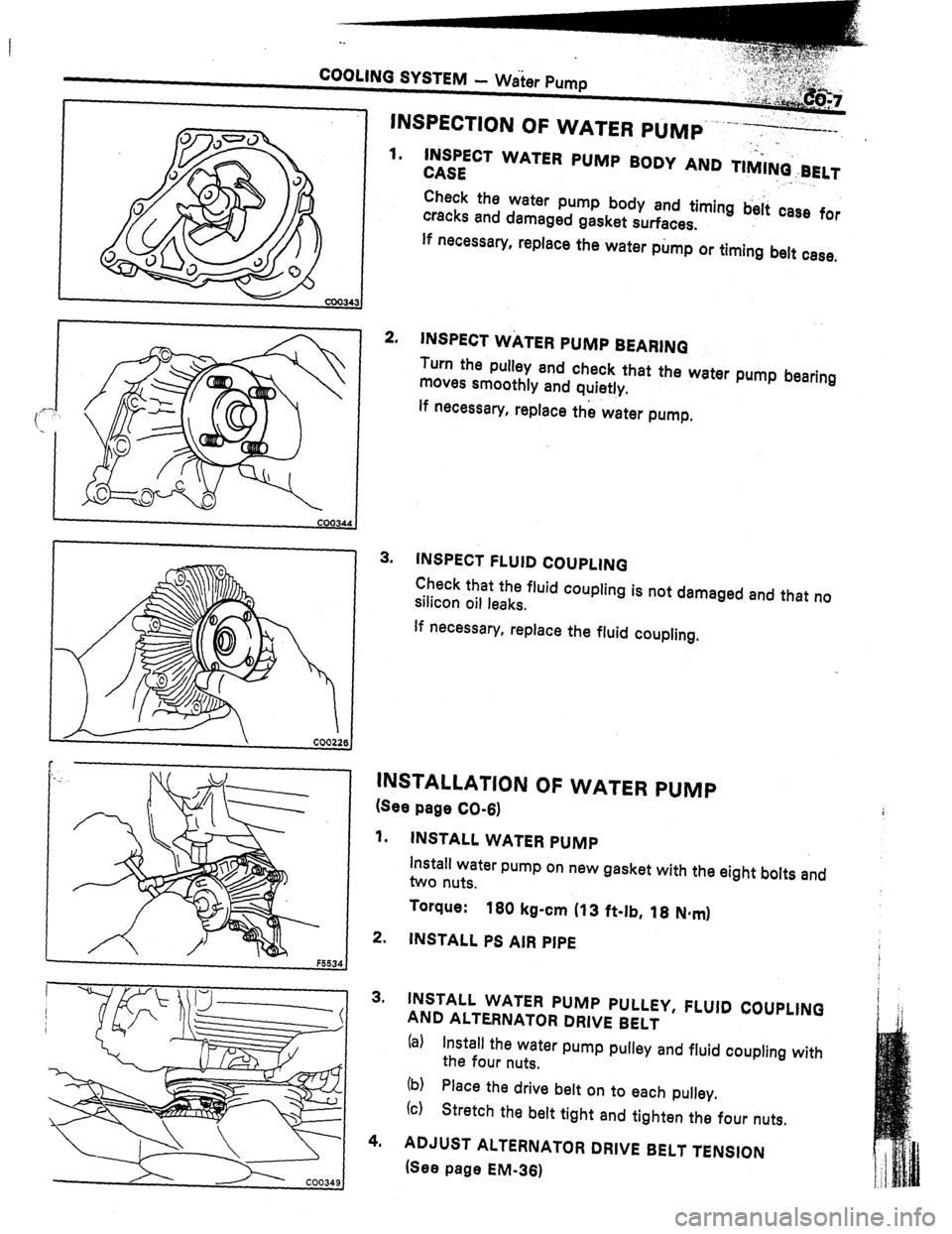
1.
2.
3.
.._ INSPECT WATER PUMP BODY AND TIMI+BELT
CASE ” ._
Check the water pump body and timing b&i case for
cracks and damaged gasket surfaces.
If necessary, replace the water pump or timing belt case,
INSPECT WATER PUMP BEARINQ
Turn the pulley and check that the water pump bearing
moves smoothly and quietly.
lf necessary, replace the water pump,
INSPECT FLUID COUPLING
Check that the fluid coupling is not damaged and that no
silicon oil leaks.
If necessary, replace the fluid coupling.
INSTALLATION OF WATER PUMP
(See page CO-6)
1. INSTALL WATER PUMP
install water pump on new gasket with the eight bolts and
two nuts.
Torque:
160 kg-cm (13 ft-lb, 18 N*mI
2. INSTALL PS AIR PIPE
3. INSTALL WATER PUMP PULLEY, FLUID COUPLING
AND ALTERNATOR DRIVE BELT
(al Install the water pump pulley and fluid coupling with
the four nuts.
(b)
(c) Place the drive belt on to each pulley.
Stretch the belt tight and tighten the four nuts.
4. ADJUST ALTERNATOR DRIVE BELT TENSION
(See page EM-361
Page 30 of 346
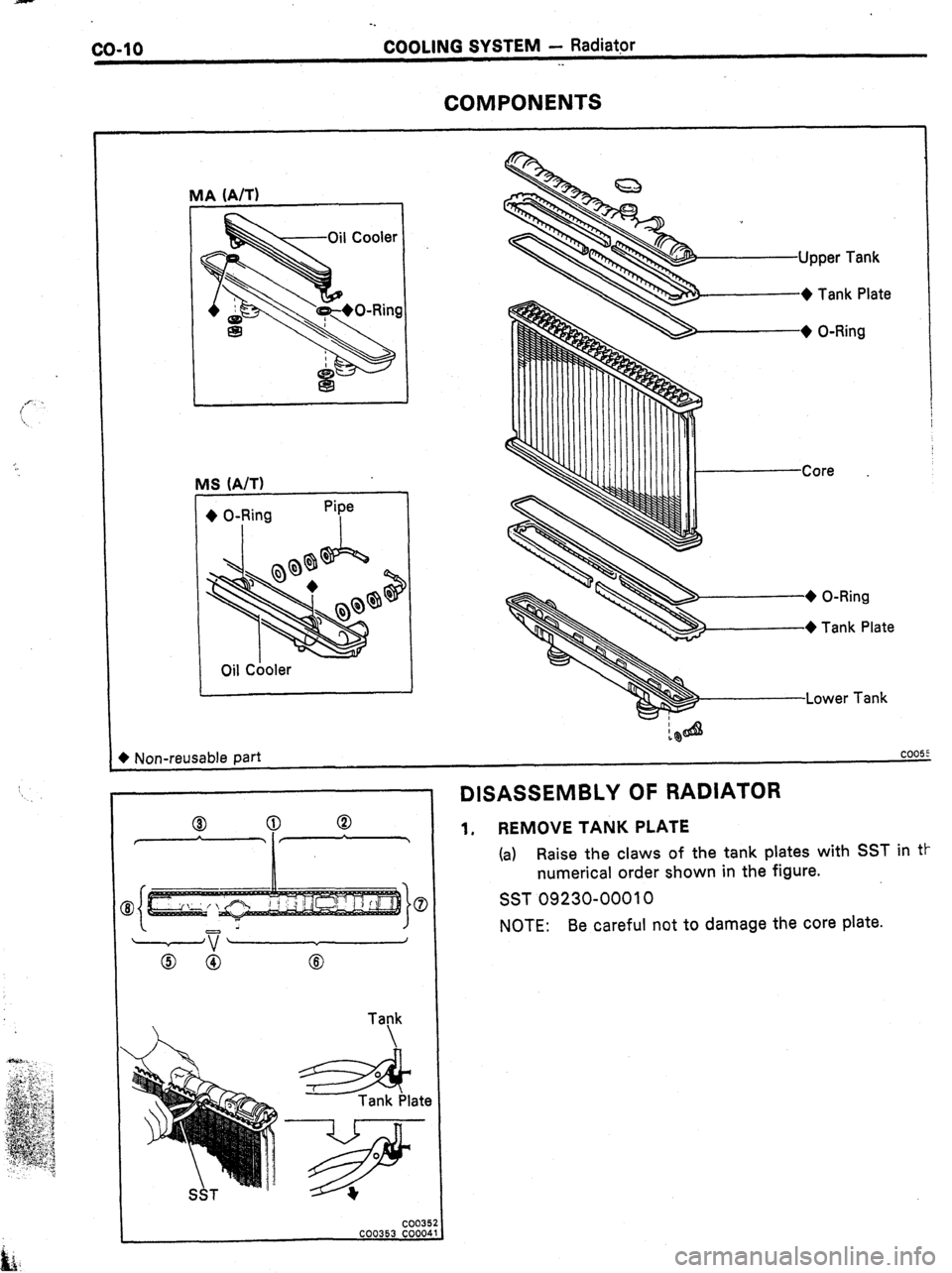
CO-IO
-.
COOLING SYSTEM - Radiatpr
. .
COMPONENTS
IA (A/T)
MS (A/T)
+ O-Ring
I
Oil Cooler Pipe
I
1
Upper Tank
-+ Tank Plate
,+ 0-Rina
I I I I
I I I I I I I I I I I ICore
Lower
Tank
+ Non-reusable part
coo55
SST - I
DISASSEMBLY OF RADIATOR
1. REMOVE TANK PLATE
(a)
Raise the claws of the tank plates with SST in tt-
numerical order shown in the figure.
SST 09230-00010
NOTE:
Be careful not to damage the core plate.
Page 31 of 346
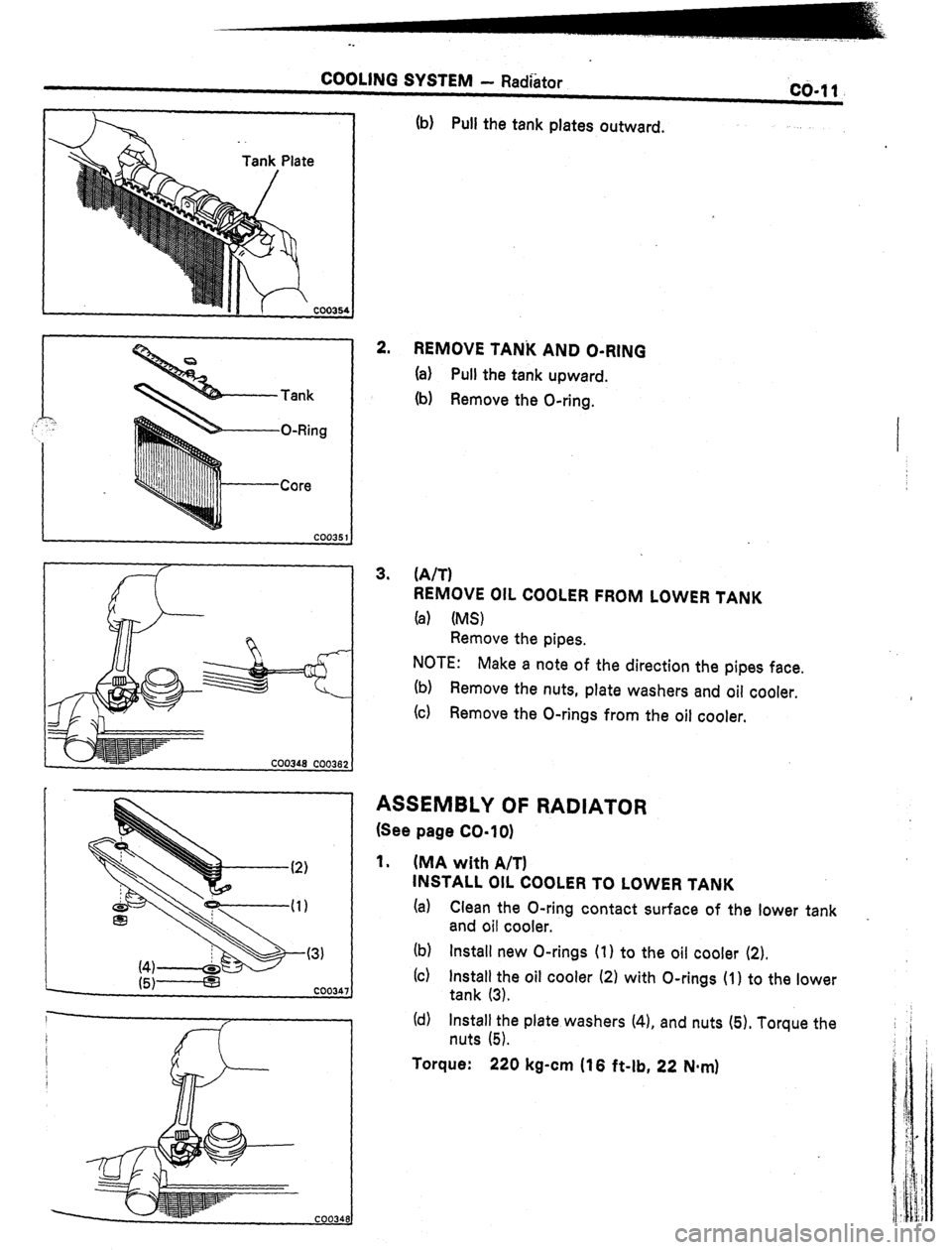
COOLING SYSTEM - Radhtor co-11
Tank
O-Ring
Core
(b) Pull the tank plates outward.
2.
REMOVE TANi( AND O-RING
(a) Pull the tank upward.
(b) Remove the O-ring.
3. (A/T)
REMOVE OIL COOLER FROM LOWER TANK
(a) (MS)
Remove the pipes.
NOTE:
Make a note of the direction the pipes face.
(b) Remove the nuts, plate washers and oil cooler.
(c) Remove the O-rings from the oil cooler.
ASSEMBLY OF RADIATOR
(See page CO-lo)
1. (MA with A/T)
INSTALL OIL COOLER TO LOWER TANK
(a) Clean the O-ring contact surface of the lower tank
and oil cooler. _
(b) Install new O-rings (1) to the oil cooler (2).
(c) Install the oil cooler (2) with O-rings (1) to the lower
tank (3).
(d) Install the plate washers (4). and nuts (5). Torque the
nuts (5).
Torque: 220 kg-cm (16 f&lb, 22 Nqn)
Page 32 of 346
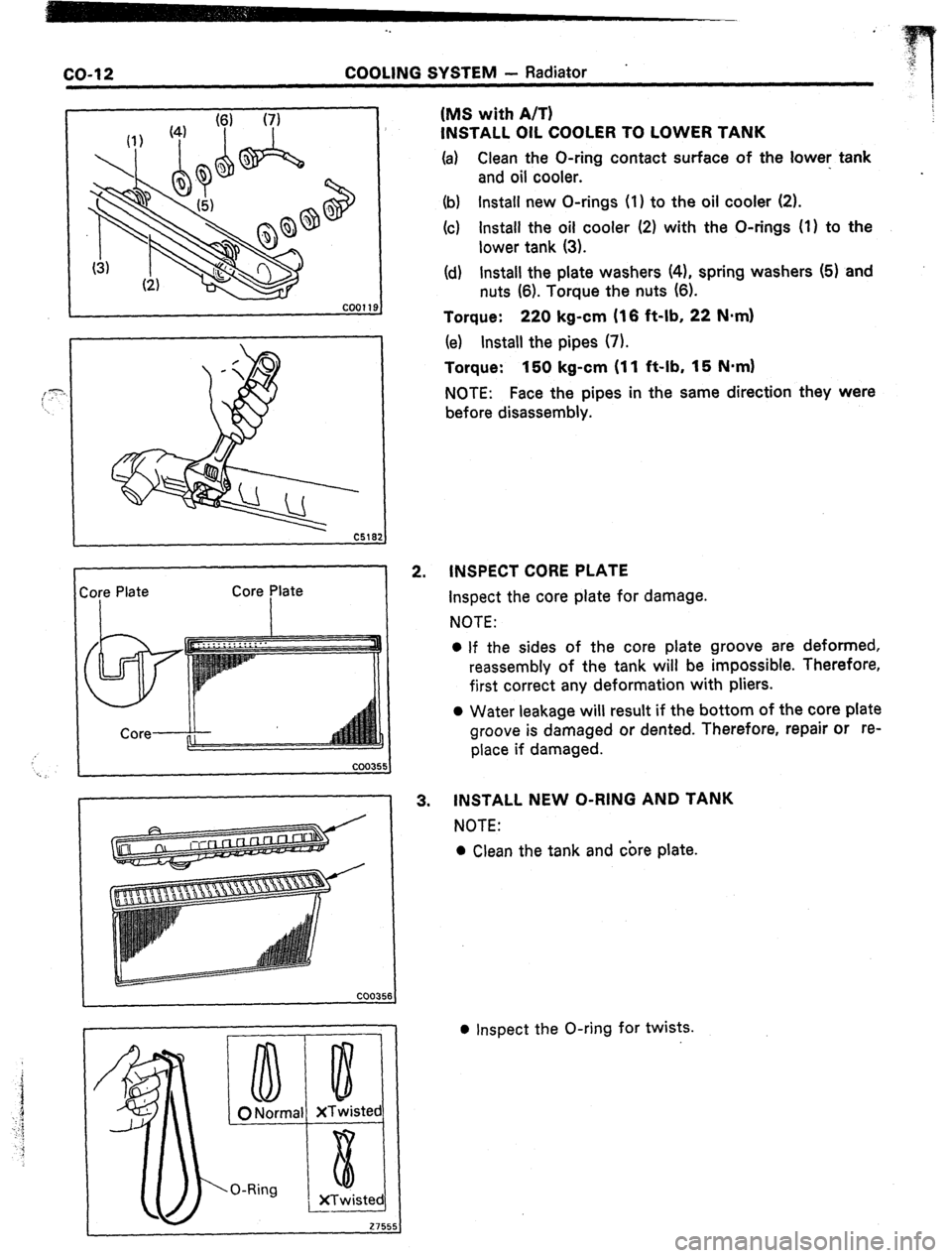
-.
COOLING SYSTEM - Radiator
.
ore
Plate
Core plate
XTwisteq
XTwistedl
- 2755:
2. (MS with A/T)
INSTALL OIL COOLER TO LOWER TANK
(a)
Clean the O-ring contact surface of the
lower: tank
and oil cooler.
(b) Install new O-rings (1) to the oil cooler (2).
(c) Install the oil cooler (2) with the O-rings (1) to the
lower tank (3).
(d) Install the plate washers (41, spring washers (5) and
nuts (6). Torque the nuts (6).
Torque: 220 kg-cm (16 ft-lb, 22 N*m)
(e) Install the pipes (7).
Torque: 150 kg-cm (11 ft-lb, 15 N.mI
NOTE: Face the pipes in the same direction they were
before disassembly.
INSPECT CORE PLATE
Inspect the core plate for damage.
NOTE:
l If the sides of the core plate groove are deformed,
reassembly of the tank will be impossible. Therefore,
first correct any deformation with pliers.
0 Water leakage will result if the bottom of the core plate
groove is damaged or dented. Therefore, repair or re-
place if damaged.
3. INSTALL NEW O-RING AND TANK
NOTE:
l Clean the tank and core plate.
l Inspect the O-ring for twists.